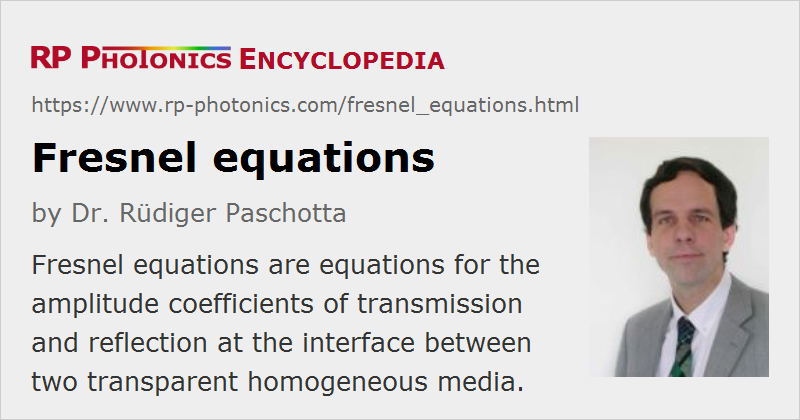Fresnel Equations
Definition: equations for the amplitude coefficients of transmission and reflection at the interface between two transparent homogeneous media
How to cite the article; suggest additional literature
Author: Dr. Rüdiger Paschotta
Fresnel equations specify the amplitude coefficients for transmission and reflection at the interface between two transparent homogeneous media:

For example, ts is the amplitude transmission coefficient for s polarization; the transmitted amplitude is that factor times the incident amplitude in that case (disregarding any phase changes for transmission in the media). n1 and n2 are the refractive indices of the two media. The corresponding propagation angles (measured against the normal direction) are θ1 and θ2 (see Figure 1).
For example, the amplitude transmission coefficient is ts for s polarization, i.e., if the electric field vector is perpendicular to the plane of incidence.
The power reflection coefficients are obtained simply by taking the modulus squared of the corresponding amplitude coefficients. For the transmission, one must add a factor (n2 cos θ2) / (n1 cos θ1) in order to take into account the different propagation angles.

Figure 2 shows in an example case how the reflectivity of the interface depends on the angle of incidence and the polarization. The reflection coefficient vanishes for p polarization if the angle of incidence is Brewster's angle (here: ≈55.4°).
For the simplest case with normal incidence on the interface, the power reflectivity (which is the modulus squared of the amplitude reflectivity) can be calculated with the following equation:

Application to Absorbing Media
Fresnel equations can also be applied to absorbing media, including metals. In that case, a complex refractive index needs to be used; the imaginary part is related to the absorbance. The reflection and transmission coefficients are then generally no more real numbers.
A difficulty occurs concerning the calculation of power transmission in cases with non-normal incidence. The above mentioned correction factor for taking into account the different propagation angles will be complex, but the power transmission factor would of course have to be a real number. The problem is related to the fact that the optical intensity is no longer constant along the wavefronts.
Questions and Comments from Users
Here you can submit questions and comments. As far as they get accepted by the author, they will appear above this paragraph together with the author’s answer. The author will decide on acceptance based on certain criteria. Essentially, the issue must be of sufficiently broad interest.
Please do not enter personal data here; we would otherwise delete it soon. (See also our privacy declaration.) If you wish to receive personal feedback or consultancy from the author, please contact him e.g. via e-mail.
By submitting the information, you give your consent to the potential publication of your inputs on our website according to our rules. (If you later retract your consent, we will delete those inputs.) As your inputs are first reviewed by the author, they may be published with some delay.
See also: Fresnel reflections, reflectivity, transmissivity, refraction, total internal reflection, Brewster's angle, refractive index
and other articles in the category general optics
 |





If you like this page, please share the link with your friends and colleagues, e.g. via social media:
These sharing buttons are implemented in a privacy-friendly way!